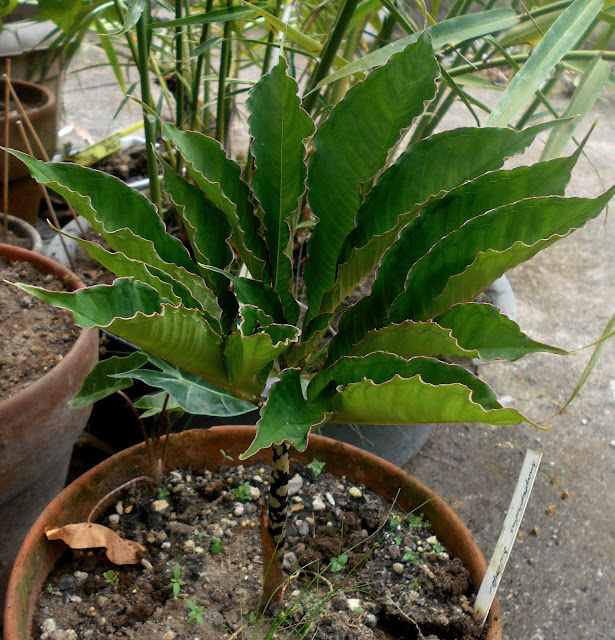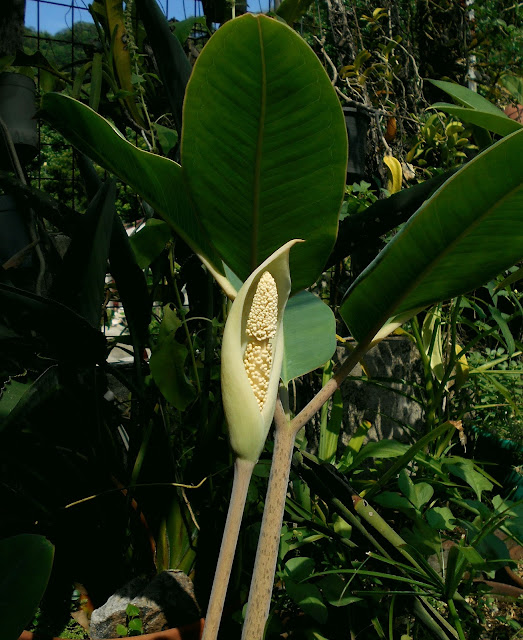Of philosophy and Amorphophallus
"The two most powerful warriors are patience and time."
-Leo Tolstoy
Ask anyone who grows aroids and are therefore familiar with Amorphophallus but would not want to grow Amorphophallus, and you'll receive these two answers the most frequently as to why they don't and won't: they stink and they go dormant. The odor of the inflorescences in most species is a given. However, there are those with rather fragrant odors and there are those that are innocuous, scent-wise. And yet, these same plants are still nowhere near as commonly cultivated as any other aroid. Besides, most Amorphophallus species bloom very unpredictably and infrequently; an Amorphophallus in flower is an event of its own like I said numerous times previously. When a plant you have had for a decade flowers for the first time, you really would not worry about the olfactory assault, would you? The bloom will last for just a few days, to be repeated for who knows when- another decade, perhaps? A seldom-seen species in flower is always bragging rights for the most seasoned collector; a badge, nay, a rank above your peers, even. So the scent for which species in this genus is known for seems, at best, only a trifle excuse to not have the most spectacular inflorescences in all Araceae being present in one's venerable collection.
 |
| Amorphophallus bulbifer, one of the most common species in Amorphophallus collections worldwide. |
The dormancy is an entirely another story, one which, acquiesce I must, truly is of legitimate concern. When not in the active phase, one is left with from a few to dozens of seemingly empty, forlorn-looking pots. Nothing is of interest, yet precious space is taken. Furthermore, work is far from being on a vacation for the gardener. Inspection for the health of the dormant tubers as well as for pests (nematodes is a concern for collectors worldwide. Thankfully, I don't have them here), division and detachment of offsets, storing (if you wish to go this route. I don't), and preparation of fresh media are parts of an equation when maintaining Amorphophallus. For Asian species, keeping the soil slightly moist is a prerequisite even during the plants' dormancy or one will end up with crumbled, desiccated tubers. All that maintenance and preparatory work for pots containing only soil and plants that your visitors do not know exists. It doesn't even really matter if the plants were planted directly on the ground: you still can't put anything around or above them. During the early years of cultivating these plants, and this was in the mid-part of the last decade though I have been seeing them in the wild and in cultivation a few years prior, I do acknowledge that the empty-looking pots are an inconvenience. Still, to consider abandoning Amorphophallus cultivation, even momentarily, is tantamount to treason How could I turn myself away from plants that possess the most memorable inflorescences and the most varied petiole markings and berry color of ALL aroids? Amorphophallus cultivation as a whole is on an entirely higher plane. There are species that keep you always on the edge, but the payback is immense, however fleeting. For all your hard work, a plant may reward you with a bloom like no other but which lasts for less than a week. Consider it ample paycheck in the presence of haughty royalties. If you say you like strange plants and have the usual crew of stapeliads, caudiciforms, myrmecophytes, and carnivores but do not have even a single Amorphophallus, then your interpretation of the word 'strange' is wanting. Go get a starter pack of at least five different species and inch your way toward the higher order of elite connoisseurs who sneer at glorified yet common plants placed atop flimsy pedestals by Instagram influencers who can only maintain the easiest and most obliging of house plants.
 |
| Inflorescences of even the plainer species still command attention in any collection. Amorphophallus salmoneus is pictured here. |
The past years have ushered me into a philosophical state into maintaining Amorphophallus and other plants that do enter dormancy, and this includes some gingers, Gloriosa, and a few other aroids. I came to realize, correctly I presume, that one does not really maintain the plants in the present- one is preparing them for the next growing season. If you get it right this growing season, you'll see either a considerable leaf jump the following year, or even one of those near-mythical blooms. It is beautifully out of sync, always. You are in the now but you are doing it for the future. If you get too caught up with the exigencies of life at the expense of paying attention to your wards, you'll end up with a rotted plant, or at best, one that showed no marked improvement from last year's growth, a testament to your growing skills and commitment, or lack of both. Know what you are doing, or there will be heartache. But if it's any consolation, know that even the most experienced collectors of these plants do often experience setbacks. Few other plants can bring humility knocking back at your door.
 |
| How often does this happen in one year? Just once, on average. Amorphophallus variabilis from Bogor is illustrated here. |
 |
| Amorphophallus fornicatus, a recently described limestone species from eastern Luzon. |
At best, an Amorphophallus may be in active phase for nine months but can be as short as six. If all your plants constitute Amorphophallus species and hybrids then that leaves you with about half a year with nothing of real interest. Smaller plants of giant species such as A. titanum may not go dormant for a couple of years but it's far from being the norm. The ephemeral nature of these plants has put off many plant people from even considering adding them in a collection. And yet, this same nature also makes these plants really quite special, at least to my eyes. If you have ever watched Troy then you must remember the scene played out between Brad Pitt's Achilles and Rose Byrne's Briseis where the former said to the latter "The gods envy us. They envy us because we're mortal. 'Cause any moment may be our last. Everything is more beautiful because we're doomed. You will never be lovelier than you are now. We will never be here again." The transient presence of these plants probably helps explain why their growers fall head over heels over something as mundane as a leaf unfurling. There is palpable excitement over the first signs of life that is seldom bestowed on other plants, with the possible exception of ferns, though here the anticipation is for the unfurling fronds' architectonic design than the subconscious awareness that in general, the unfolding of an Amorphophallus leaf often happens just once a year. Once a leaf wilts, another season has to arrive to make possible another awakening.
"Everything is more beautiful because we're doomed." Life is indeed short. But one can always argue that there might be something to look forward to after the end has been attained.
My own awareness of the effects of time seems altered with these plants. Time feels stretched. It seems slowed down, lulling me into an artificial sense that I, too, am aging very slowly. In a sense, it's almost like sowing a seed of a tree and knowing that you will never live long enough to see its full majesty, but still quite different. Amorphophallus requires your time but unlike trees, they offer you hope that you will see within your lifetime what you have always wanted to see from them- that is, if they allow you. So you refine your growing skills and wait. And wait further until you finally bear witness to the fruits- or maybe I should say, inflorescences- of your labor. But you very well know that it is but an inconsequential victory. A pitcher plant enthusiast with a sizeable collection will be able to see the traps of all his wards in a very short period of time. An orchid collector with thousands of species may see the flowers of all his plants in just a few years' efforts. But I don't think there is anyone out there who has managed to bloom even half of the known Amorphophallus species (with the possible exception of the late Alan Galloway), which currently stands in the low 200s. It is not just a concern about growing spaces but a consideration of time. What I find truly curious here is how these plants are able to express both brevity and lengthy spans of time in their nature. A plant that cannot even last for a full year in leaf and yet decides to bloom only after a decade- maybe even longer- is a bit strenuous for human-derived realities to comprehend. Although one way of looking at it is that like us, these plants have higher goals that cannot be accomplished in one quick stroke. It takes perseverance and time. Time which is dissected in growing seasons and of winter rests. Of rebirth at the first promise of spring and the setting of higher goals and once accomplished, respite, and gathering enough strength again to set even higher objectives. It is a circle that keeps growing and expanding, one small arc at a time. Because:
"No great thing is created suddenly."
-Epictetus
 |
| Amorphophallus saururus is one of the easier species to flower in cultivation. In a period of five years, you'll likely to see your plant blooming twice, maybe thrice if you're quite lucky. |





Comments
Post a Comment